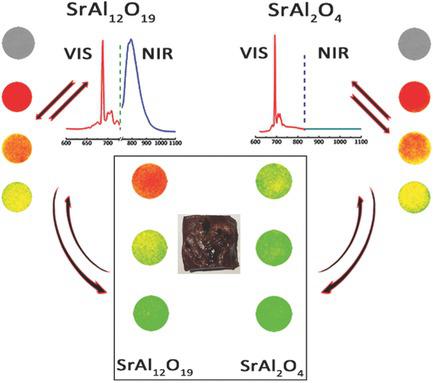当前位置:
X-MOL 学术
›
Adv. Opt. Mater.
›
论文详情
Our official English website, www.x-mol.net, welcomes your feedback! (Note: you will need to create a separate account there.)
Coordination Geometry‐Dependent Multi‐Band Emission and Atypically Deep‐Trap‐Dominated NIR Persistent Luminescence from Chromium‐Doped Aluminates
Advanced Optical Materials ( IF 9 ) Pub Date : 2018-02-05 , DOI: 10.1002/adom.201701161 Xiaohui Lin 1 , Ruili Zhang 2 , Xiumei Tian 3 , Yang Li 1, 4, 5 , Bingsheng Du 1 , Jianmin Nie 5 , Zhenzhang Li 1 , Li Chen 1 , Jinjun Ren 2 , Jianrong Qiu 6 , Yihua Hu 1
Advanced Optical Materials ( IF 9 ) Pub Date : 2018-02-05 , DOI: 10.1002/adom.201701161 Xiaohui Lin 1 , Ruili Zhang 2 , Xiumei Tian 3 , Yang Li 1, 4, 5 , Bingsheng Du 1 , Jianmin Nie 5 , Zhenzhang Li 1 , Li Chen 1 , Jinjun Ren 2 , Jianrong Qiu 6 , Yihua Hu 1
Affiliation

|
An abnormal trap distribution and coordination geometry‐dependent multi‐band emission are discovered in chromium‐doped aluminates. The multi‐band and broadband persistent luminescence from 650–1100 nm peaking at 688 and 793 nm from Cr3+‐doped SrAl12O19 is systematically studied via structural and spectroscopic analysis. Solid state nuclear magnetic resonance allows the visualization of various coordination configurations in SrAl12O19, thus offering the possibility of tailoring the local geometry of the emission center to trigger the control of the spectral parameter. Deep tissue ex vivo and in vivo imaging in mice both demonstrate that multi‐band‐emissive SrAl12O19:Cr3+ shows superior, high‐quality near‐infrared (NIR) bio‐imaging in the biological transparency window compared to single band‐emissive (with emission only at 688 nm) SrAl2O4:Cr3+, although SrAl2O4:Cr3+ has a higher luminescent intensity and longer duration at 688 nm. Moreover, by measuring the thermoluminescence spectra the driving force of carrier release is discovered to be only from the deep trap (the depth is > 1 eV), which is different from the generally accepted shallow‐dependent afterglow‐emitting process. These findings pave the way for opening a vista of possible avenues for the enhancement of signal‐to‐noise ratio, the improvement of imaging quality, as well as the understanding of the trapping and de‐trapping process in long‐persistent phosphors.
中文翻译:

铬掺杂铝酸盐的配位几何相关的多频带发射和非典型的深陷阱主导的NIR持久发光
在掺铬铝酸盐中发现了异常的陷阱分布和与配位几何相关的多波段发射。通过结构和光谱分析,系统地研究了Cr 3+掺杂SrAl 12 O 19在650和1100 nm处在688和793 nm处达到峰值的多波段和宽带持续发光。固态核磁共振允许可视化SrAl 12 O 19中的各种配位构型,从而提供了定制发射中心的局部几何形状以触发光谱参数控制的可能性。小鼠体内深部组织的离体和体内成像均表明多波段发射SrAl 12 O 19:Cr 3+与单波段发射(仅在688 nm处发射)相比,在生物透明窗口中显示出优越的高质量近红外(NIR)生物成像SrAl 2 O 4:Cr 3+,尽管SrAl 2 O 4:铬3+具有较高的发光强度,并在688 nm处具有更长的持续时间。此外,通过测量热致发光光谱,发现载流子释放的驱动力仅来自深陷阱(深度> 1 eV),这与通常公认的浅依赖性余辉发射过程不同。这些发现为扩大信噪比,改善成像质量以及了解持久性磷光体的俘获和去俘获过程提供了可能的途径。
更新日期:2018-02-05
中文翻译:

铬掺杂铝酸盐的配位几何相关的多频带发射和非典型的深陷阱主导的NIR持久发光
在掺铬铝酸盐中发现了异常的陷阱分布和与配位几何相关的多波段发射。通过结构和光谱分析,系统地研究了Cr 3+掺杂SrAl 12 O 19在650和1100 nm处在688和793 nm处达到峰值的多波段和宽带持续发光。固态核磁共振允许可视化SrAl 12 O 19中的各种配位构型,从而提供了定制发射中心的局部几何形状以触发光谱参数控制的可能性。小鼠体内深部组织的离体和体内成像均表明多波段发射SrAl 12 O 19:Cr 3+与单波段发射(仅在688 nm处发射)相比,在生物透明窗口中显示出优越的高质量近红外(NIR)生物成像SrAl 2 O 4:Cr 3+,尽管SrAl 2 O 4:铬3+具有较高的发光强度,并在688 nm处具有更长的持续时间。此外,通过测量热致发光光谱,发现载流子释放的驱动力仅来自深陷阱(深度> 1 eV),这与通常公认的浅依赖性余辉发射过程不同。这些发现为扩大信噪比,改善成像质量以及了解持久性磷光体的俘获和去俘获过程提供了可能的途径。



























 京公网安备 11010802027423号
京公网安备 11010802027423号